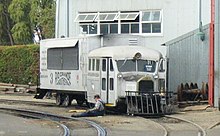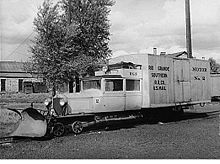
A railcar is a self-propelled railway vehicle designed to transport passengers. The term "railcar" is usually used in reference to a train consisting of a single coach, with a driver's cab at one or both ends. Some railway companies, such as the Great Western, termed such vehicles "railmotors".
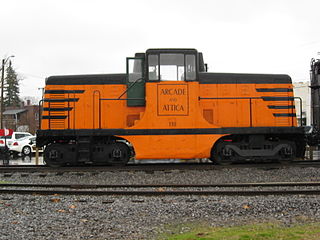
The Arcade and Attica Railroad is a shortline railroad that hauls freight between Arcade and North Java, New York. The railroad originally connected Arcade with Attica; however, the right of way from North Java north to Attica was abandoned in 1957 due to flooding on the Tonawanda Creek.
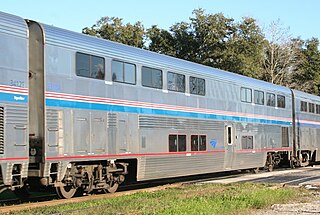
A passenger railroad car or passenger car, also called a passenger carriage, passenger coach, or passenger bogie is a railroad car that is designed to carry passengers. The term passenger car can also be associated with a sleeping car, a baggage car, a dining car, railway post office and prisoner transport cars.
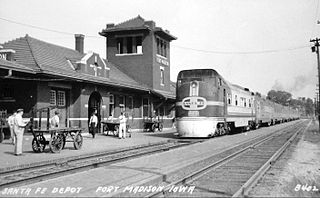
Electro-Motive Corporation produced five 1800 hp B-B experimental passenger train-hauling diesel locomotives in 1935; two company-owned demonstrators, #511 and #512, the Baltimore and Ohio Railroad's #50, and two units for the Atchison, Topeka and Santa Fe Railway, Diesel Locomotive #1. The twin engine power unit layout and multiple unit control systems developed with the B-B locomotives were soon adopted for other locomotives such as the Burlington Route's Zephyr locomotives built by the Budd Company in 1936 and EMC's own EMD E-units introduced in 1937. The B-B locomotives worked as proof-of-concept demonstrators for diesel power with the service loads of full size trains, breaking out of its niche powering the smaller custom Streamliners.
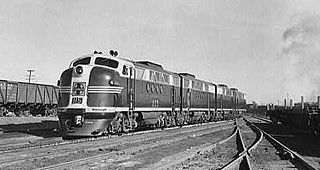
The EMD FT is a 1,350-horsepower (1,010 kW) diesel-electric locomotive that was produced between March 1939 and November 1945, by General Motors' Electro-Motive Corporation (EMC), later known as GM Electro-Motive Division (EMD). The "F" stood for Fourteen Hundred (1400) horsepower and the "T" for Twin, as it came standard in a two-unit set. The design was developed from the TA model built for the C,RI&P in 1937, and was similar in cylinder count, axle count, length, and layout. All told 555 cab-equipped ”A” units were built, along with 541 cabless booster or ”B” units, for a grand total of 1,096 units. The locomotives were all sold to customers in the United States. It was the first model in EMD's very successful F-unit series of cab unit freight diesels and was the locomotive that convinced many U.S. railroads that the diesel-electric freight locomotive was the future. Many rail historians consider the FT one of the most important locomotive models of all time.

EMD F-units are a line of diesel-electric locomotives produced between November 1939 and November 1960 by General Motors Electro-Motive Division and General Motors-Diesel Division. Final assembly for all F-units was at the GM-EMD plant at La Grange, Illinois, and the GMDD plant in London, Ontario. They were sold to railroads throughout the United States, Canada and Mexico, and a few were exported to Saudi Arabia. The term F-unit refers to the model numbers given to each successive type, all of which began with the letter F. The F originally meant "fourteen", as in 1,400 horsepower (1,000 kW), not "freight". Longer EMD E-units for passenger service had twin 900-horsepower (670 kW) diesel engines. The E meant "eighteen" as in 1,800 horsepower (1,300 kW). Similarly, for early model EMD switchers, S meant "six hundred" and N meant "nine hundred horsepower".

The SDP45 is a six-axle, C-C, 3,600-horsepower (2,680 kW) diesel-electric locomotive built by General Motors' Electro-Motive Division of La Grange, Illinois. It was a passenger-hauling version of the SD45 on a stretched locomotive frame with an extended, squared-off long hood at the rear, aft of the radiators, giving space for a steam generator for passenger train heating. This steam generator placement followed the pattern set by the SDP35 and SDP40.

The Consolidation Line was a series of diesel-electric railway locomotive designs produced by Fairbanks-Morse and its Canadian licensee, the Canadian Locomotive Company. Railfans have dubbed these locomotives “C-liners”, however F-M referred to the models collectively as the C-Line. A combined total of 165 units were produced by F-M and the CLC between 1950 and 1955.

An SDP40 is a 6-axle passenger diesel-electric locomotive built by General Motors Electro-Motive Division (EMD) between June 1966 and May 1970.

The Durango and Silverton Narrow Gauge Railroad, often abbreviated as the D&SNG, is a 3 ft (914 mm) narrow-gauge heritage railroad that operates on 45.2 mi (72.7 km) of track between Durango and Silverton, in the U.S. state of Colorado. The railway is a federally-designated National Historic Landmark and was also designated by the American Society of Civil Engineers as a National Historic Civil Engineering Landmark in 1968.

The ALCO RS-1 was a 4-axle diesel-electric locomotive built by Alco-GE between 1941 and 1953 and the American Locomotive Company from 1953 to 1960. ALCO subsidiary Montreal Locomotive Works built an additional three RS-1s in 1954. This model has the distinction of having the longest production run of any diesel locomotive for the North American market. The RS-1 was in production for 19 years from the first unit Rock Island #748 in March 1941 to the last unit National of Mexico #5663 in March 1960.

The Ghost Town & Calico Railway is a 3 ft narrow-gauge heritage railroad and amusement park attraction within Knott's Berry Farm, an amusement park located in Buena Park, California.

The Rio Grande Southern Railroad was a 3 ft (914 mm) narrow-gauge railroad which ran in the southwestern region of the US state of Colorado, from the towns of Durango to Ridgway, routed via Lizard Head Pass. Built by German immigrant and Colorado toll road builder Otto Mears, the RGS operated from 1891 through 1951 and was built with the intent to transport immense amounts of silver mineral traffic that were being produced by the mining communities of Rico and Telluride. On both ends of the railroad, there were interchanges with The Denver and Rio Grande Railroad, which would ship the traffic the RGS hauled elsewhere like the San Juan Smelter in Durango.

Baldwin Locomotive Works produced several different Baldwin DR-6 models of 6-axle passenger train-hauling diesel locomotives between 1945 and 1948. The series comprised eight individual versions, all of which sold only in small numbers; across all versions, only 39 locomotives were produced. Each version was produced only for a single railroad. Many shared the same Baldwin model number, DR-6-4-2000, even though they were rather different; this was because the Baldwin model only encoded the total axles (6), the driven axles (4) and the power output. The single exception was the single unit produced for the Chicago and North Western Railway, which had a single 1,000 hp (750 kW) engine and was model number DR-6-2-1000. In the AAR wheel arrangement scheme of classification, these locomotives were of A1A-A1A and A1A-3 arrangements, respectively.
The Pennsylvania Railroad's class P5 comprised 92 mixed-traffic electric locomotives constructed 1931–1935 by the PRR, Westinghouse and General Electric. Although the original intention was that they work mainly passenger trains, the success of the GG1 locomotives meant that the P5 class were mostly used on freight. A single survivor, prototype #4700, is at the National Museum of Transportation in St Louis, Missouri.
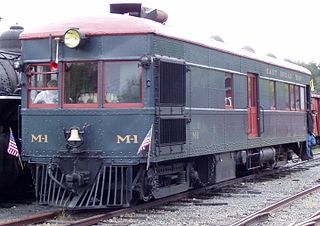
Doodlebug or hoodlebug is a nickname in the United States for a type of self-propelled railcar most commonly configured to carry both passengers and freight, often dedicated baggage, mail or express, as in a combine. The name is said to have derived from the insect-like appearance of the units, as well as the slow speeds at which they would doddle or "doodle" down the tracks. Early models were usually powered by a gasoline engine, with either a mechanical drive train or a generator providing electricity to traction motors ("gas-electrics"). In later years, it was common for doodlebugs to be repowered with a diesel engine.

The Pioneer III railcar was a short/medium-distance coach designed and built by the Budd Company in 1956 with an emphasis on weight savings. A single prototype was built, but declines in rail passenger traffic resulted in a lack of orders so Budd re-designed the concept as an electric multiple unit (m.u.). Six of the EMU coach design were purchased by the Pennsylvania Railroad with the intention of using them as a high-speed self-contained coach that could be used for long-distance commuter or short-distance intercity travel in the Northeast U.S. The 6 production Pioneer III units were the first all-stainless-steel-bodied EMU railcar built in North America and, at 90,000 pounds (41,000 kg), the lightest.

Rio Grande Southern Railroad (RGS), Motor No. 2 is a gasoline engine-powered narrow gauge railroad motorcar. It was converted on August 12, 1931 from a 1927 Buick Master Six 4-door sedan in a conversion known as a Galloping Goose. The Buick was cut behind the rear doorpost and extended with sheet metal 18 inches (46 cm) to form an enlarged passenger compartment. With no functional use, the steering column was removed. The couch from the RGS office become the back seat as it is shown being requisitioned for Goose No. 2 on the statement covering construction. The front axle was removed and replaced with a swiveling, two-axle lightweight railroad truck with 16 in (41 cm)-diameter wheels that carried and guided the front of the Goose. Ahead of the front truck the pilot is attached to the frame. There were two small pivoted scrapers attached to the rear of the pilot to keep small objects on the track from derailing the lightweight front truck. During the winter season a small snowplow was attached to the front of the pilot.

Rio Grande Southern Railroad (RGS), Motor Number 6 is a gasoline engine powered narrow gauge railroad motor car. The Galloping Goose body and chassis were built from a Buick automobile. The new Buick body was cut off behind the front seat and a new rear wall installed. The steering wheel was removed as it was not needed, but the other controls remained. The front axle was removed and replaced with a swiveling two axle lightweight railroad truck with sixteen inch diameter wheels that carried and guided the front of the Goose. Ahead of the front truck is the pilot attached to the frame. Two small pivoted scrapers attached to the rear of the pilot slide on the rails to keep small objects on the track from derailing the lightweight front truck. During the winter season a small snow plow was attached to the front of the pilot. The rear of the car frame was lengthened using steel channel riveted together but welded to the frame to carry the truck type flat-bed platform. The bed has short stake racks around the sides to keep materials from falling off. The Goose was originally powered by the 6-cylinder engine, clutch and transmission that came with the Buick. The drive chain powers the rear swiveling two axle truck assembly mounted under the rear frame and platform bed. The drive shaft turns only the forward axle. The rearmost axle is driven by roller chains and sprockets mounted outside of the wheels on each side. The rear truck has twenty four-inch diameter cast wheels. The braking is accomplished by brake shoes between the axles on each truck being pushed against the wheel treads. These are actuated by linkage connecting them to the normal foot pedal and parking brake lever. The foot brake is connected to the front truck and the parking brake lever is connected to the rear truck. Goose No. 6 received air brakes about 1939. The paint colors of Goose No. 6 early on is still an item of much discussion. Examination of the paint layers on the rear bed revealed only black and then aluminum that was used after 1935.

The Budd–Michelin rubber-tired rail cars were built by the Budd Company in the United States between 1931 and 1933 using French firm Michelin's "Micheline" rail car design. Michelin built its first rail car in 1929, and by 1932 had built a fleet of nine cars that all featured innovative and distinctive pneumatic tires. In September 1931, an agreement signed between the two companies allowed Budd to use the new rubber rail tires on its shot-welded, stainless-steel carbodies, and at the same time allowed Michelin to expand into the American market.



